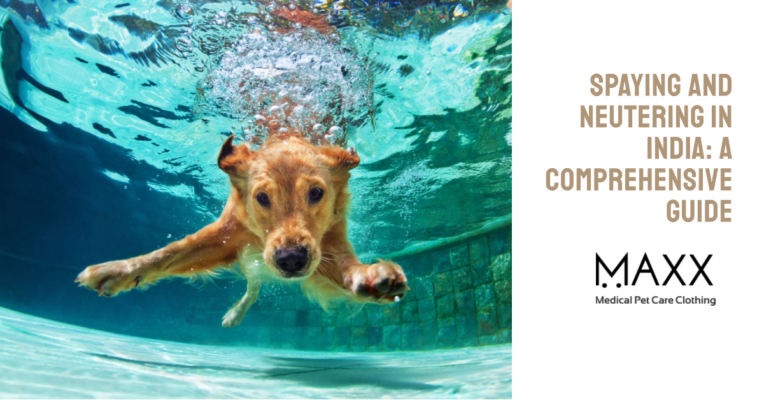MAXX Pet Blogs
Spaying and Neutering in India: A Comprehensive Guide
As pet owners, we have a responsibility towards our furry companions to ensure their well-being and safety.
Spaying and neutering our pets is one way to fulfill this responsibility.
It not only helps control the pet population but also offers several health benefits to our beloved pets.
In this article, we will discuss the spaying and neutering process in India, including the cost, benefits, and risks associated with it.
After a pet undergoes surgery, it is important to take extra care to ensure their recovery is as smooth and comfortable as possible.
One way to help with this is by using surgical pet shirts.
These shirts are designed to fit snugly around your pet’s body and provide support to the surgical site.
They can also help prevent your pet from licking or biting at the incision area, which can lead to infection or delayed healing.
Surgical pet shirts are available in different sizes and styles, so it is important to consult with your veterinarian to determine which type is best for your pet.
By using a surgical pet shirt after surgery, you can help ensure your pet’s recovery is successful and comfortable
1. What is Spaying and Neutering?
Spaying and neutering refer to surgical procedures performed on pets to prevent them from reproducing.
Spaying is the surgical removal of the ovaries and uterus of a female pet, while neutering is the surgical removal of the testicles of a male pet.
2. Benefits of Spaying and Neutering
There are several benefits to spaying and neutering our pets.
First and foremost, it helps control the pet population and prevents unwanted litters. It also reduces the risk of certain types of cancers, such as breast cancer and testicular cancer.
Spaying and neutering can also decrease the likelihood of certain behavioral problems, such as aggression and roaming.
3. Cost of Spaying and Neutering in India
The cost of spaying and neutering in India can vary depending on several factors, such as the type of pet, the age of the pet, and the location of the veterinary clinic.
On average, spaying a female dog can cost anywhere from Rs. 3,000 to Rs. 10,000, while neutering a male dog can cost anywhere from Rs. 2,000 to Rs. 8,000.
Spaying a female cat can cost anywhere from Rs. 1,500 to Rs. 5,000, while neutering a male cat can cost anywhere from Rs. 1,000 to Rs. 3,000.
4. How to Spay a Dog at Home
It is not recommended to spay a dog at home as it is a complex surgical procedure that requires specialized training and equipment. Attempting to spay a dog at home can lead to serious complications and even death. It is best to leave this procedure to trained and licensed veterinary professionals.
5. Female Dog Operation to Not Have Babies Cost
The cost of a female dog operation to prevent them from having babies can vary depending on the type of procedure performed.
Spaying, which is the surgical removal of the ovaries and uterus, is typically more expensive than other procedures.
On average, spaying a female dog can cost anywhere from Rs. 3,000 to Rs. 10,000.
6. Cat Spaying Cost Near Me
The cost of spaying a cat can vary depending on the location of the veterinary clinic. It is best to check with local veterinary clinics to get an estimate of the cost. On average, spaying a female cat can cost anywhere from Rs. 1,500 to Rs. 5,000.
7. Neutering Dogs Meaning
Neutering a dog refers to the surgical removal of the testicles.
It is a common procedure performed on male dogs to prevent them from reproducing.
Neutering can also reduce the risk of certain types of cancers, such as testicular cancer, and decrease the likelihood of certain behavioral problems, such as aggression and roaming.
8. Risks and Complications Associated with Spaying and Neutering
While spaying and neutering have several benefits, they also come with some risks and complications.
The surgical procedures involve anesthesia, which can be risky for pets with certain health conditions.
Pets may also experience pain and discomfort after the surgery, and there is a risk of infection or bleeding.
However, the benefits of spaying and neutering usually outweigh the risks.
9. FAQs on Spaying and Neutering
- Is spaying and neutering painful for pets?
- While the surgical procedures involve anesthesia, pets may experience some pain and discomfort after the surgery. However, veterinarians will usually prescribe pain medication to help manage the pain.
- When is the best time to spay or neuter a pet?
- The best time to spay or neuter a pet depends on several factors, such as the type of pet and the breed. It is best to consult with a veterinarian to determine the best time for your pet.
- Can spaying or neutering affect a pet’s behavior?
- Spaying or neutering can decrease the likelihood of certain behavioral problems, such as aggression and roaming. However, it is not a guarantee that it will eliminate all behavior problems.
- Can spaying or neutering make a pet gain weight?
- Spaying or neutering can slightly increase the risk of weight gain in pets. However, this can be managed through proper diet and exercise.
- Can spaying or neutering affect a pet’s lifespan?
- Spaying or neutering can reduce the risk of certain types of cancers, which can potentially increase a pet’s lifespan.
In conclusion, spaying and neutering our pets is a crucial step in ensuring their health and well-being. While it may come with some risks and complications, the benefits of spaying and neutering usually outweigh the risks. As responsible pet owners, we should prioritize spaying and neutering our pets to prevent unwanted litters and promote a healthy pet population.
Visit Maxx.Pet for more information on pet care and supplies.


